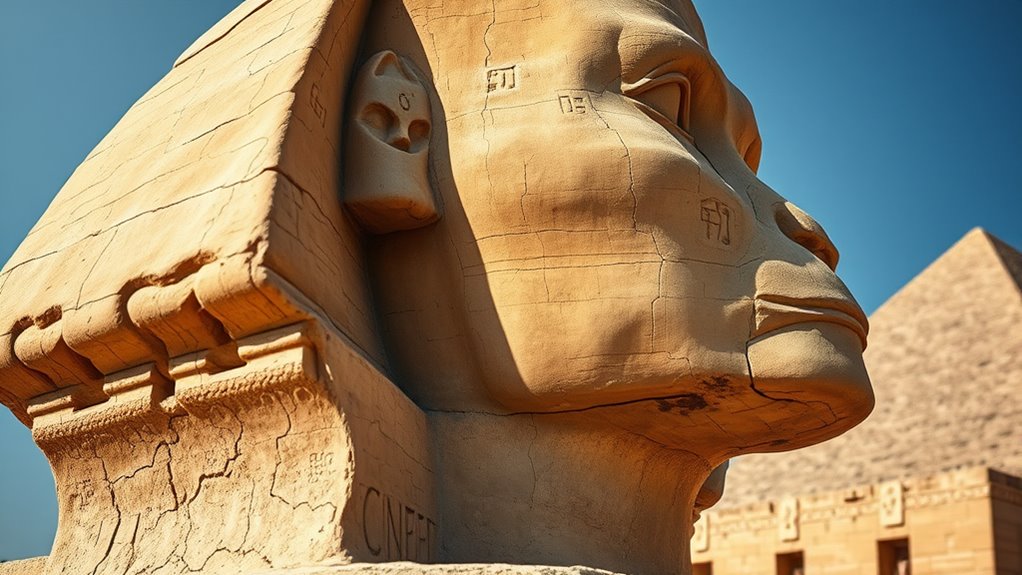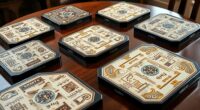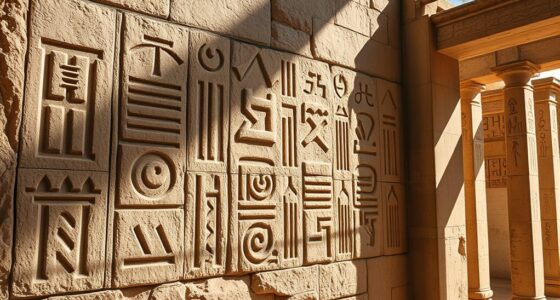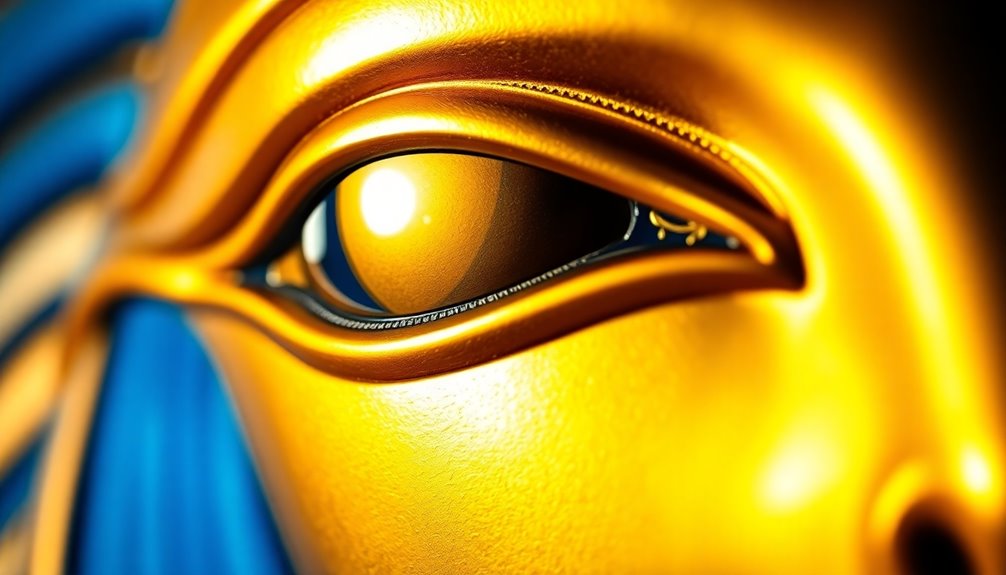The ancient Sphinx is famous for its riddles that test human wisdom and curiosity, symbolizing mystery and inner strength. While many of these riddles have been passed down through myths, some are lost to time, shrouded in history and symbolism. These questions often explore themes of life, knowledge, and human nature, reflecting the creature’s role as a guardian of secrets. To uncover the stories behind these mysterious questions, there’s more waiting for you to explore.
Key Takeaways
- The most famous Sphinx riddle is about human life: “What walks on four legs in the morning…”
- Many ancient riddles are lost or only referenced indirectly, making their original questions uncertain.
- Sphinx riddles symbolize universal themes of mystery, wisdom, and human curiosity across cultures.
- The symbolism behind Sphinx riddles reflects cultural values like intelligence, resilience, and divine protection.
- Modern interpretations explore the deeper meaning of the lost questions as metaphors for life’s mysteries and knowledge.

Sphinx riddles have fascinated people for centuries, challenging minds with cryptic questions that demand clever thinking. These riddles are deeply rooted in mythological origins, especially from ancient Egypt and Greece, where the Sphinx was a symbol of mystery and wisdom. In Greek mythology, the Sphinx was a creature with the body of a lion, wings of an eagle, and the head of a woman. It guarded the city of Thebes, presenting travelers with riddles that determined their fate. If you failed to answer correctly, disaster awaited. This mythological background emphasizes the creature’s role as a keeper of secrets and a test of intellect, which still fuels our curiosity today. Over time, the Sphinx emerged as a powerful cultural symbol, representing the challenge of unraveling hidden knowledge and understanding complex truths. It’s no coincidence that riddles associated with the Sphinx often symbolize the human struggle to decipher mysteries and confront the unknown.
When you explore the history of these riddles, you discover that they’re more than just puzzles; they embody cultural symbolism. In Egyptian mythology, the Sphinx is linked to the sun god Ra and the concept of divine protection. Its imposing figure, often carved from limestone, guards sacred spaces and signifies strength and endurance. This association with divine authority underscores the importance of wisdom and insight in the culture. In Greek stories, the riddle posed by the Sphinx was a way to test individuals’ intelligence and moral character. The famous question, “What walks on four legs in the morning, two legs at noon, and three legs in the evening?” exemplifies how riddles serve as allegories for human existence and the cycle of life. The Sphinx becomes a symbol of human curiosity, resilience, and the pursuit of knowledge, echoing across different civilizations.
You can see how the mythological origins and cultural symbolism of the Sphinx are intertwined, shaping how we interpret these riddles today. They stand as metaphors for the challenges you face in understanding the world around you, requiring sharp wit and deep insight. Whether depicted as a guardian or a symbol of divine wisdom, the Sphinx’s riddles continue to captivate minds because they tap into universal themes of mystery, discovery, and human ingenuity. These cryptic questions have survived for ages because they resonate with your innate desire to solve puzzles and uncover truths hidden beneath layers of myth and mythos. So, when you encounter a Sphinx riddle, remember it’s not just a puzzle but a reflection of centuries of cultural symbolism and mythological origins that invite you to think beyond the surface.
Additionally, exploring the symbolism behind mythological creatures can deepen your understanding of the universal themes embedded in these riddles and stories.
Frequently Asked Questions
Are the Original Sphinx Riddles Still Relevant Today?
You might wonder if the original sphinx riddles are still relevant today. They embody ancient symbolism and mythological symbolism that can still resonate with us. These riddles challenge your thinking, encouraging you to explore deeper meanings and cultural stories. Their timeless nature keeps them meaningful, reminding us of the power of mythological symbolism and ancient wisdom. So, yes, they remain relevant, inspiring curiosity and reflection across ages.
How Have Sphinx Riddles Influenced Modern Puzzles?
Think of modern puzzles as a tapestry woven from ancient threads of mythical symbolism. Sphinx riddles have shaped puzzle design by emphasizing clues that challenge your wit and logic. They inspire creators to craft riddles that merge myth with mystery, encouraging deeper thinking. Today’s puzzles often echo that blend, making the solving experience richer and more engaging. You’re part of a legacy that turns timeless myth into contemporary mental adventure.
What Are the Historical Origins of the Sphinx Riddles?
You’re curious about the origins of sphinx riddles, which stem from ancient symbolism and mythological origins. These riddles originate in Greek mythology, where the sphinx was a creature of mystery and wisdom. Historically, they served as tests of intelligence and moral virtue. The riddles reflect the cultural values of ancient civilizations, blending symbolism and myth to challenge and teach, shaping storytelling and puzzle traditions that endure today.
Do Different Cultures Have Similar Riddles to the Sphinx?
You’d be amazed at how many cultures have riddles similar to the sphinx’s, showcasing a universal human curiosity. These cultural comparisons reveal that riddle evolution is a shared part of human history, from ancient China’s brain teasers to Native American puzzles. Each culture adapts riddles to fit their values, yet they all serve the same purpose: to challenge wit and wisdom across time and borders.
Can Sphinx Riddles Be Used for Educational Purposes?
You can definitely use sphinx riddles for educational purposes. They challenge you to develop critical thinking skills and enhance your vocabulary as you analyze and interpret the riddles. By solving these riddles, you engage in active learning that promotes problem-solving and creative thinking. Incorporating sphinx riddles into lessons makes learning more interactive and fun, helping you build cognitive skills while expanding your language knowledge.
Conclusion
Now that you’ve explored the mysteries of the Sphinx riddles, you realize there’s always more beneath the surface. These ancient puzzles remind us that not everything is as straightforward as it seems, and sometimes, you have to read between the lines. Keep questioning and stay curious—after all, the devil’s in the details. The more you dig, the more you’ll uncover, proving that knowledge is a journey, not a destination.











